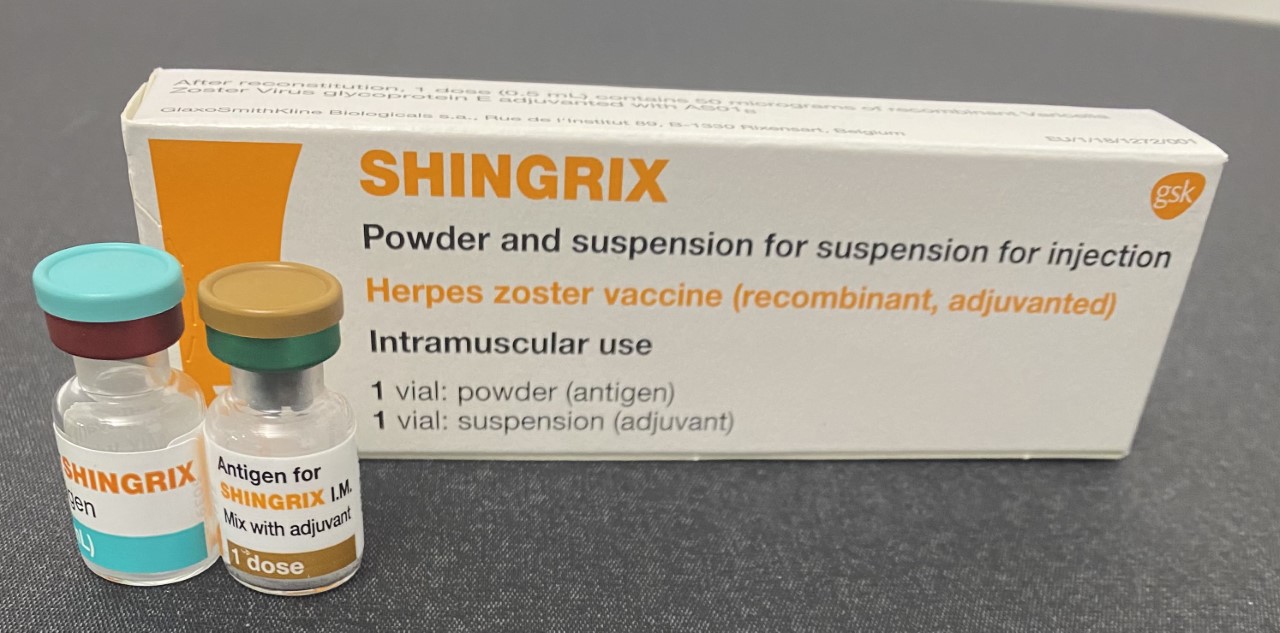|
Shingles
Shingles, also known as herpes zoster or zona, is a viral disease characterized by a painful skin rash with blisters in a localized area. Typically the rash occurs in a single, wide mark either on the left or right side of the body or face. Two to four days before the rash occurs there may be paresthesia, tingling or local pain in the area. Other common symptoms are fever, headache, and tiredness. The rash usually heals within two to four weeks, but some people develop ongoing neuropathy, nerve pain which can last for months or years, a condition called postherpetic neuralgia (PHN). In those with Immunosuppression, poor immune function the #Disseminated shingles, rash may occur widely. If the rash involves the eye, vision loss may occur. Shingles is caused by the varicella zoster virus (VZV) that also causes chickenpox. In the case of chickenpox, also called varicella, the initial infection with the virus typically occurs during childhood or adolescence. Once the chickenpox ha ... [...More Info...] [...Related Items...] OR: [Wikipedia] [Google] [Baidu] |
Shingles Vaccine
A zoster vaccine is a vaccine that reduces the incidence of herpes zoster (shingles), a disease caused by reactivation of the varicella zoster virus, which is also responsible for chickenpox. Shingles provokes a painful rash with blisters, and can be followed by chronic pain (postherpetic neuralgia), as well as other complications. Older people are more often affected, as are people with weakened immune systems (immunosuppression). Both shingles and postherpetic neuralgia can be prevented by vaccination. Two zoster vaccines have been approved for use in people over 50 years old. Shingrix ( GSK) is a recombinant subunit vaccine which has been used in many countries since 2017. Zostavax ( Merck), in use since 2006, is an attenuated vaccine which consists of a larger-than-normal dose of chickenpox vaccine. Unlike Shingrix, Zostavax is not suitable for people with immunosuppression or diseases that affect the immune system. Zostavax was discontinued in the United States in No ... [...More Info...] [...Related Items...] OR: [Wikipedia] [Google] [Baidu] |
Chickenpox
Chickenpox, also known as varicella ( ), is a highly contagious disease caused by varicella zoster virus (VZV), a member of the herpesvirus family. The disease results in a characteristic skin rash that forms small, itchy blisters, which eventually scab over. It usually starts on the chest, back, and face. It then spreads to the rest of the body. The rash and other symptoms, such as fever, tiredness, and headaches, usually last five to seven days. Complications may occasionally include pneumonia, inflammation of the brain, and bacterial skin infections. The disease is usually more severe in adults than in children. Chickenpox is an airborne disease which easily spreads via human-to-human transmission, typically through the coughs and sneezes of an infected person. The incubation period is 10–21 days, after which the characteristic rash appears. It may be spread from one to two days before the rash appears until all lesions have crusted over. It may also spread through ... [...More Info...] [...Related Items...] OR: [Wikipedia] [Google] [Baidu] |
Postherpetic Neuralgia
Postherpetic neuralgia (PHN) is neuropathic pain that occurs due to damage to a peripheral nerve caused by the reactivation of the varicella zoster virus ( herpes zoster, also known as shingles). PHN is defined as pain in a dermatomal distribution that lasts for at least 90 days after an outbreak of herpes zoster. Several types of pain may occur with PHN including continuous burning pain, episodes of severe shooting or electric-like pain, and a heightened sensitivity to gentle touch which would not otherwise cause pain or to painful stimuli. Abnormal sensations and itching may also occur. Postherpetic neuralgia is the most common long-term complication of herpes zoster, and occurs in approximately 20% of patients with shingles. Risk factors for PHN include older age, severe prodrome or rash, severe acute zoster pain, ophthalmic involvement, immunosuppression, and chronic conditions such as diabetes mellitus and lupus. The pain from postherpetic neuralgia can be very severe an ... [...More Info...] [...Related Items...] OR: [Wikipedia] [Google] [Baidu] |
Varicella Zoster Virus
Varicella zoster virus (VZV), also known as human herpesvirus 3 (HHV-3, HHV3), is one of nine known herpes viruses that can infect humans. It causes chickenpox (varicella) commonly affecting children and young adults, and shingles (herpes zoster) in adults but rarely in children. As a late complication of VZV infection, Ramsay Hunt syndrome type 2 may develop in rare cases. VZV infections are species-specific to humans. The virus can survive in external environments for a few hours. VZV multiplies in the tonsils, and causes a wide variety of symptoms. Similar to the herpes simplex viruses, after primary infection with VZV (chickenpox), the virus lies dormant in neurons, including the cranial nerve ganglia, dorsal root ganglia, and autonomic ganglia. Many years after the person has recovered from initial chickenpox infection, VZV can ''reactivate'' to cause shingles. Epidemiology Chickenpox Primary varicella zoster virus infection results in chickenpox (varicella), whic ... [...More Info...] [...Related Items...] OR: [Wikipedia] [Google] [Baidu] |
Herpesvirus
''Orthoherpesviridae'', previously named and more widely known as ''Herpesviridae'', is a large family of DNA viruses that cause infections and certain diseases in animals, including humans. The members of this family are commonly known as herpesviruses. The family name is derived from the Greek word ἕρπειν ( 'to creep'), referring to spreading cutaneous lesions, usually involving blisters, seen in flares of herpes simplex 1, herpes simplex 2 and herpes zoster ( shingles). In 1971, the International Committee on the Taxonomy of Viruses (ICTV) established ''Herpesvirus'' as a genus with 23 viruses among four groups. Since then, the number of identified herpesviruses has grown to more than 100. Herpesviruses can cause both latent and lytic infections. Nine herpesvirus types are known to primarily infect humans, at least five of which are extremely widespread among most human populations, and which cause common diseases: herpes simplex 1 and 2 (HSV-1 and HSV-2, also know ... [...More Info...] [...Related Items...] OR: [Wikipedia] [Google] [Baidu] |
Aciclovir
Aciclovir, also known as acyclovir, is an antiviral medication. It is primarily used for the treatment of herpes simplex virus infections, chickenpox, and shingles. Other uses include the prevention of cytomegalovirus infections following transplant, and severe complications of Epstein–Barr virus infection. It can be taken by mouth, applied as a cream, or injected. Common side effects include nausea and diarrhea. Potentially serious side effects include kidney problems and low platelets. Greater care is recommended in those with poor liver or kidney function. It is generally considered safe for use in pregnancy with no harm having been observed. It appears to be safe during breastfeeding. Aciclovir is a nucleoside analogue that mimics guanosine. It works by decreasing the production of the virus's DNA. Aciclovir was patented in 1974, by Burroughs Wellcome, and approved for medical use in 1981. It is on the World Health Organization's List of Essential Medicines. It is a ... [...More Info...] [...Related Items...] OR: [Wikipedia] [Google] [Baidu] |
Paresthesia
Paresthesia is a sensation of the skin that may feel like numbness (''hypoesthesia''), tingling, pricking, chilling, or burning. It can be temporary or Chronic condition, chronic and has many possible underlying causes. Paresthesia is usually painless and can occur anywhere on the body, but most commonly in the arms and legs. The most familiar kind of paresthesia is the sensation known as ''pins and needles'' after having a limb "fall asleep" (''obdormition''). A less common kind is formication, the sensation of insects crawling on the skin. Causes Transient Paresthesias of the hands, feet, legs, and arms are common transient symptoms. The briefest electric shock type of paresthesia can be caused by tweaking the ulnar nerve near the elbow; this phenomenon is colloquially known as bumping one's "funny bone". Similar brief shocks can be experienced when any other nerve is tweaked (e.g. a pinched neck nerve may cause a brief shock-like paresthesia toward the scalp). In the older a ... [...More Info...] [...Related Items...] OR: [Wikipedia] [Google] [Baidu] |
Aciclovir
Aciclovir, also known as acyclovir, is an antiviral medication. It is primarily used for the treatment of herpes simplex virus infections, chickenpox, and shingles. Other uses include the prevention of cytomegalovirus infections following transplant, and severe complications of Epstein–Barr virus infection. It can be taken by mouth, applied as a cream, or injected. Common side effects include nausea and diarrhea. Potentially serious side effects include kidney problems and low platelets. Greater care is recommended in those with poor liver or kidney function. It is generally considered safe for use in pregnancy with no harm having been observed. It appears to be safe during breastfeeding. Aciclovir is a nucleoside analogue that mimics guanosine. It works by decreasing the production of the virus's DNA. Aciclovir was patented in 1974, by Burroughs Wellcome, and approved for medical use in 1981. It is on the World Health Organization's List of Essential Medicines. It is a ... [...More Info...] [...Related Items...] OR: [Wikipedia] [Google] [Baidu] |
Neuropathy
Peripheral neuropathy, often shortened to neuropathy, refers to damage or disease affecting the nerves. Damage to nerves may impair sensation, movement, gland function, and/or organ function depending on which nerve fibers are affected. Neuropathies affecting motor, sensory, or autonomic nerve fibers result in different symptoms. More than one type of fiber may be affected simultaneously. Peripheral neuropathy may be acute (with sudden onset, rapid progress) or chronic (symptoms begin subtly and progress slowly), and may be reversible or permanent. Common causes include systemic diseases (such as diabetes or leprosy), hyperglycemia-induced glycation, vitamin deficiency, medication (e.g., chemotherapy, or commonly prescribed antibiotics including metronidazole and the fluoroquinolone class of antibiotics (such as ciprofloxacin, levofloxacin, moxifloxacin)), traumatic injury, ischemia, radiation therapy, excessive alcohol consumption, immune system disease, celiac dis ... [...More Info...] [...Related Items...] OR: [Wikipedia] [Google] [Baidu] |
Keratitis
Keratitis is a condition in which the human eye, eye's cornea, the clear dome on the front surface of the eye, becomes inflammation, inflamed. The condition is often marked by moderate to intense pain and usually involves any of the following symptoms: pain, impaired eyesight, photophobia (light sensitivity), Red eye (medicine), red eye and a 'gritty' sensation. Diagnosis of infectious keratitis is usually made clinically based on the signs and symptoms as well as eye examination, but corneal scrapings may be obtained and evaluated using microbiological culture or other testing to identify the causative pathogen. Classification (by chronicity) Acute * Acute epithelial keratitis * Nummular keratitis * Interstitial keratitis * Disciform keratitis Chronic * Neurotrophic keratitis * Mucous plaque keratitis Classification (infective) Viral The most common causes of viral keratitis include herpes simplex virus (HSV) and varicella zoster virus (VZV), which cause herpes of the eye ... [...More Info...] [...Related Items...] OR: [Wikipedia] [Google] [Baidu] |





